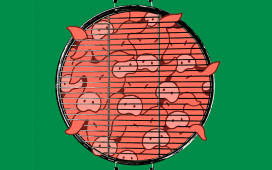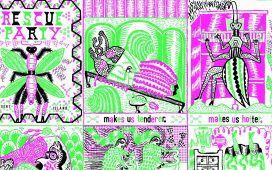The New York Film Festival opens this weekend under a shadow of mourning, because of the death, on Tuesday, of the filmmaker Melvin Van Peebles, whose third feature, “Sweet Sweetback’s Baadasssss Song,” will play in the festival’s Revivals section, in a new restoration. His first feature, from 1967, “The Story of a Three-Day Pass,” which was filmed in France, presents a scathing view of the experiences of a Black American soldier, with a freely imaginative aesthetic that unfolds that character’s inner conflicts. In “Sweet Sweetback’s Baadasssss Song,” from 1971, filmed in Los Angeles and other California locations, Van Peebles—working as an independent filmmaker, writing and directing and even starring in the movie (he even financed and retained ownership of it)—deploys a similar stylistic audacity, and to even bolder political ends. It’s the story of an apolitical entertainer of sorts—a Black male sex worker and freelance stud, a performer in an erotic show—who, after enduring police brutality, becomes an accidental revolutionary. Van Peebles’s vision of the devastating police violence that Black Americans endure at home (indeed, even literally inside their homes), and of the resulting deformations of their ordinary lives into an extraordinary heroism of resistance (or merely of survival)—has an eruptive urgency. By way of fragmentation, distortion, and a sense of frantic haste, Van Peebles fuses together his sense of just anger in bearing witness to such realities, his pain-filled aversion to filming such unbearable truths, and his relentless sense of purpose in nonetheless flinging them onto the screen.
For all its horror, “Sweet Sweetback” has an exuberant, hedonistic excitement. With the titular character, Van Peebles rips to shreds the era’s cinematic conventions designed for white consumption. Far from the stereotypes of middle-class respectability that Hollywood then assigned to Black stars, Sweetback is brazenly sexual and happily sybaritic, without regard for how whites view him; he is admired in his own community for his sense of freedom. Little in his life suggests a political focus—until he encounters and makes common cause with a member of the Black Panther Party, at great personal cost. Sweetback’s political awakening, his violent resistance to his police persecutors, and his successful escape from them convey a spirit of outrage and revolt that no other filmmaker at the time dared to avow. A film of triumphant independence—which took in ten million dollars at the box-office soon after its release—“Sweet Sweetback” made Van Peebles a hero of the cinema and a hero of the times at large. As much as the movie is a template of independent-film artistry and a decisive forebear of Black independent filmmaking, it’s also a model of beating Hollywood at its own game—of art as a crucial form of power.
Among the new films in the festival’s first-week premières, one stands out for its political outrage and bitter defiance: “Ahed’s Knee,” by the Israeli director Nadav Lapid. From the film’s very first scene, Lapid candidly displays and furiously denounces the militarization and oppressive nationalism of Israeli society. It’s the story of a fortysomething Israeli Jewish filmmaker, identified only as Y (and played by Avshalom Pollak), who flies alongside Israeli soldiers, in a small, shuttle-like plane, to a village in the Negev desert, near the Jordanian border, where he’s presenting one of his films at a local library. A cheerful young woman named Yahalom (Nur Fibak), a native of the village who works for the country’s Ministry of Culture, greets him there. She’s as affable and welcoming as he is grumpy and skeptical, and they quickly bond—dialectically, platonically, over art and politics. He discloses to her, in great detail, the horrors of a seemingly suicidal mission that he had participated in as an Army intelligence officer. She reveals to him her unease with the censorious regulations that her ministry imposes on cultural activities. He unleashes a torrential, seemingly inexhaustible rant about Israel’s government, its ethos, and what he considers the moral and intellectual numbing of the citizenry to the country’s criminal policies—and he plans to publish a damning report about this trip.
Lapid captures this intellectualized push and pull with an avid eye for verbal aperçus and florid digressions, for peculiar characters and idiosyncratic behavior, and his aesthetic matches Y’s howling anguish. “Ahed’s Knee” isn’t a film of subtlety or nuance; it hits the nail on the head so hard that it risks shattering the hammer, and the hand that wields it, along with the wall. The movie is filled with tense long takes that tremble at the edge of violence, disorienting angles to suggest Y’s inner disarray, and jerking camera moves that match the disruptive, reckless actions that Y takes in the course of his brief desert interlude. The movie gets its title—with, of course, its allusion to Éric Rohmer’s film “Claire’s Knee”—from a project that Y is working on about a real-life Palestinian woman named Ahed Tamimi, who, as a teen-ager, was sentenced to prison for slapping an Israeli soldier, prompting a Jewish member of the Israeli government to tweet that she should have been shot in the knee and thus put “under house arrest for the rest of her life.” For a French director such as Rohmer, a woman’s knee was the crux of an elegantly dialectical erotic comedy. For Lapid, as an Israeli director, a woman’s knee is an inflection point of politics and repression, violence and power, and art is a battleground between conformity and freedom.
As the title of Maureen Fazendeiro and Miguel Gomes’s film “The Tsugua Diaries” suggests, the action, set in a town in rural Portugal, covers twenty-two days in the month of August, one by one, in reverse, counting down from day twenty-two to Day One—the span of the shooting of the film itself. (“Tsugua” is “August” backward, a trick replicated in the translation of the original Portuguese title, “Diários de Otsoga.”) The movie integrates the behind-the-scenes story of the cast and crew at work on the shoot with scenes from the movie that they’re making, and leaves it to the viewer to parse the action into its constituent elements. Yet, rather than distancing viewers from the emotional tenor of the drama, the unusual time scheme heightens it. In the opening scene, three young people, two men and a woman, dance by night in a darkly lit summer house to a record of, yes, “The Night,” by Frankie Valli and the Four Seasons. As one man drifts away and walks into the garden amid crickets and bats, the other two draw closer together and shyly, tenderly, kiss. This culminating romantic breakthrough at the head of the film sets the ardent, delicate tone for the entire drama, suffusing it with the glow of a destiny-like inevitability.
The subject of “The Tsugua Diaries” is love and filmmaking in the time of COVID. The cast and crew all play versions of themselves. Fazendeiro and Gomes respectively play the co-directors Maureen and Miguel. The actors Crista Alfaiate, Carloto Cotta, and João Nunes Monteiro play actors with the same names, and so forth. The isolated farm compound where the movie takes place serves as a bubble for cast and crew, and the mandated health protocols play crucial roles—they become subjects of debate and conflict during production meetings, and the resolution of those differences gets filtered into the story that the filmmakers shoot. That’s because the movie that Maureen and Miguel are making has no set script. They build the story on the basis of the observations of the actors and the surroundings, their conferences with crew members, and the changing behind-the-scenes relationships that develop. (They also satirize the very open-endedness of their project in scenes depicting the actors’ struggles to make use of their creative freedom.) The carpentry involved in the building of a butterfly house, a jaunt around the farm in a tractor and its flatbed trailer, a spontaneous leap into a swimming pool, and the preparation of a meal all pulsate with purpose, display creative inspiration, teem with dramatic possibilities. Fazendeiro and Gomes film the carefully tended settings with a passionate but serene observational joy and the actors with a restrained, gentle affection: in art and life alike, these people and places all shiver with the promise of love and the spectre of death.








